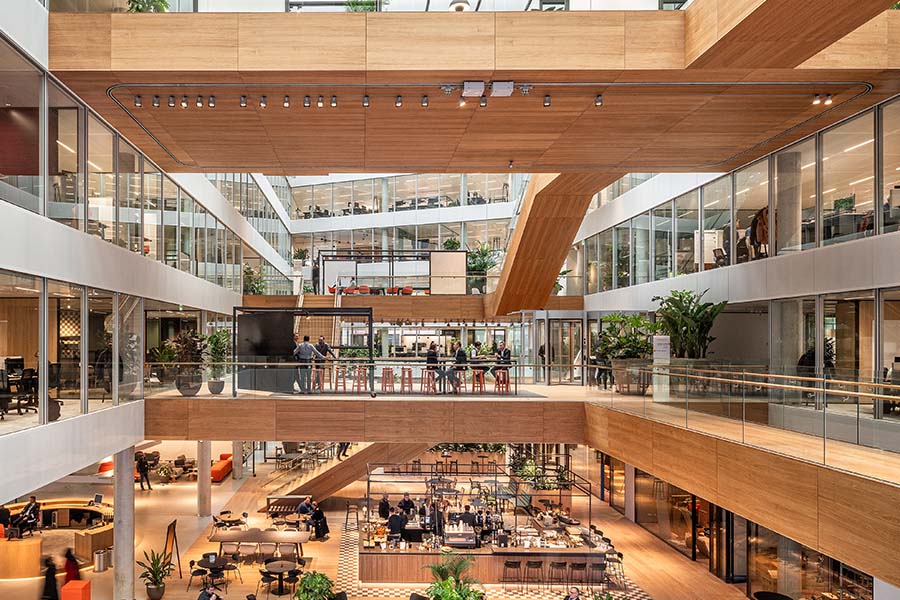When construction industry innovators talk about the challenges of greener building, the focus tends to be on new technologies, with smart materials, robotic construction and other environmentally focused initiatives claiming the spotlight. But recently, the green building conversation has centered on a surprisingly old approach: wood.
Inspired by the environmental advantages of wood construction, the city of Amsterdam in the Netherlands recently passed groundbreaking legislation mandating that all new buildings constructed after 2025 consist of at least 20% wood or other biobased material.
Built spoke to Willem Wopereis, senior architect at Dutch firm HofmanDujardin, about the challenges and rewards of wood construction and how the new mandate will influence the firm’s design practices.
Wood’s environmental advantages
Why wood? According to Wopereis, there are several ecological advantages for Dutch architects interested in the material.
“The construction industry is very polluting and responsible for around 25% of yearly CO2 emissions,” Wopereis said. “Of these, concrete and steel are accountable for over 85%. Wood, in contrast, absorbs CO2 during its growth and stores it, as long as you don’t burn it.”

While the image of clear-cut forests might make wood seem anything but environmentally friendly, Wopereis said wood is actually a more responsible choice than conventional construction materials like concrete and steel. “Using wood in construction is positive twofold: it greatly reduces the amount of pollution and even adds by storing CO2,” he said. “Unlike concrete, after a building’s lifetime, wood is very easy to reuse in new projects.”
“Moreover,” Wopereis continued, “almost all wood harvested in Europe comes from sustainable forests, which means they replant at least the same amount, and often even more. We promote the use of wood as a construction material for its positive effect on the planet and human well-being.”
Using wood in construction gives European forestry services the chance to replant, capturing even more carbon. But there are economic and legislative challenges that have so far prevented the material being used on a mass scale.

“Unfortunately, the current industry, as well as standards and regulations, are mostly based on traditional steel and concrete construction methods,” Wopereis said. “Constructing in wood is therefore still more expensive. If we want the building industry to make a serious shift toward sustainability, regulation is needed. The mandate is a good first step.”
The challenges and rewards of working with wood
Wood is one of the most ancient human construction materials, second only to clay composites. But, as Wopereis pointed out: “Since timber has not been seen as a serious alternative for a long period, there is limited knowledge over the whole chain.”
Wopereis believes that a government mandate may help provide construction professionals with a helpful direction as they begin to relearn how to work with wood as a material.
“We as architects need to learn about what types to use for what elements, what are ideal spans, dimensions, connections, etc.,” Wopereis said. “And so do structural engineers who are not used to calculating on wooden structures, as well as contractors that learn construction techniques and to plan the logistics of the building site.”

When it comes to determining methodologies for wood construction, “many technical details are different,” Wopereis said. “For example, wood responds to changes in temperature or moisture levels and has different expansion rates than concrete or steel. Keeping the right margins in connections is crucial. A much more challenging issue is acoustics, due to the lightweight nature of wood. When using wooden structural floors, an extra layer of mass is needed. Applying this in a circular way (so not by casting concrete on top) is a topic of research in the architectural field.”
Efforts to innovate wood construction may be hampered by persistent myths about the superiority of steel and concrete construction. “Often fire safety is considered as the No. 1 issue in wooden buildings, but that’s a myth,” Wopereis said. “Engineered wood types like CLT, LVL and Glulam have great fire-resistant capacities.”
Overall, Wopereis believes that many of the technical challenges posed by new methods of wood construction are worth it for the material’s green-building potential.
“At HofmanDujardin, we follow our philosophy, ‘Shaping Intuition,’ based on the natural values of human beings in their environment,” Wopereis said. “Whether we construct in wood or steel or concrete, we aim for clear, personal and inspirational buildings of high quality. Sustainability is on top of our mind. It is important to use the right material for the right purpose and take physical properties into account.”
The future of wood construction
For all of the challenges of building with wood, Wopereis said he and the rest of the HofmanDujardin team are excited about the mandate’s furthering of the creative, esthetic and environmental ideas they believe in—and have engaged in with past projects.
“One of our most-published projects is the iconic Villa Tonden,” Wopereis said. “This holiday home was built in prefab timber sandwich elements. The façades and roofs are clad with Platowood, an environmentally friendly treated softwood that doesn’t need treatment and lasts for 50 years. Another interesting example are the atrium platforms we designed for ING Cedar, where wood is used as the cladding of a steel structure. The sculptural power and spatial effect have turned the atrium into an empowering connector. Moreover, the wooden surfaces have micro perforations that improve the acoustics.”

What makes working with wood so rewarding for the HofmanDujardin team?
“We like wood for its appearance and natural warm character,” Wopereis said. “The clarity and regularity of timber structures give buildings an intrinsic quality, which we like to make visible. This means special attention is needed to the design of load-bearing structures and connections between different elements. The effect of the structure on the experience of spaces is often much bigger than in buildings made from concrete and steel. Besides visual aspects, it shows a positive effect on human comfort on multiple levels, like acoustics and air quality.”
Wopereis believes that laws like Amsterdam’s new mandate will help open other construction industry professionals’ minds about the potential of wood as a construction material.
“We hope and think that constructing in wood will become a new standard,” he said. “We believe in its positive effect on the climate and the overall well-being of people. To achieve this, new regulations and a tax on the real costs of materials is needed. We all need to pay a price for pollution. That will make building in timber economically beneficial and hence more common. No doubt we as architects will find innovative ways to work with it to create new inspiring and healthy buildings.”
Michiel Hofman, partner architect, and Barbara Dujardin, partner architect, also contributed information for this article.












